Healthcare Quality: Analysis of Patient Safety and Improvements
VerifiedAdded on 2022/10/11
|14
|3774
|16
Report
AI Summary
This report provides a comprehensive analysis of healthcare quality and patient safety, focusing on case studies from Grand River Hospital and St. Mary's General Hospital. It examines various aspects of patient care, including adverse events, infection control, and surgical practices, while also assessing the hospitals' organizational structures and nursing practices. The report analyzes data against benchmarks and national standards, identifying areas for improvement and proposing specific goals and initiatives to address deficiencies. It emphasizes the importance of infection control, improved communication, teamwork, and effective organizational management. The anticipated outcomes of the proposed quality improvement program are discussed, with a focus on enhancing healthcare services within a six-month timeframe. The report also highlights the need for re-evaluation of data to measure the effectiveness of the implemented strategies.
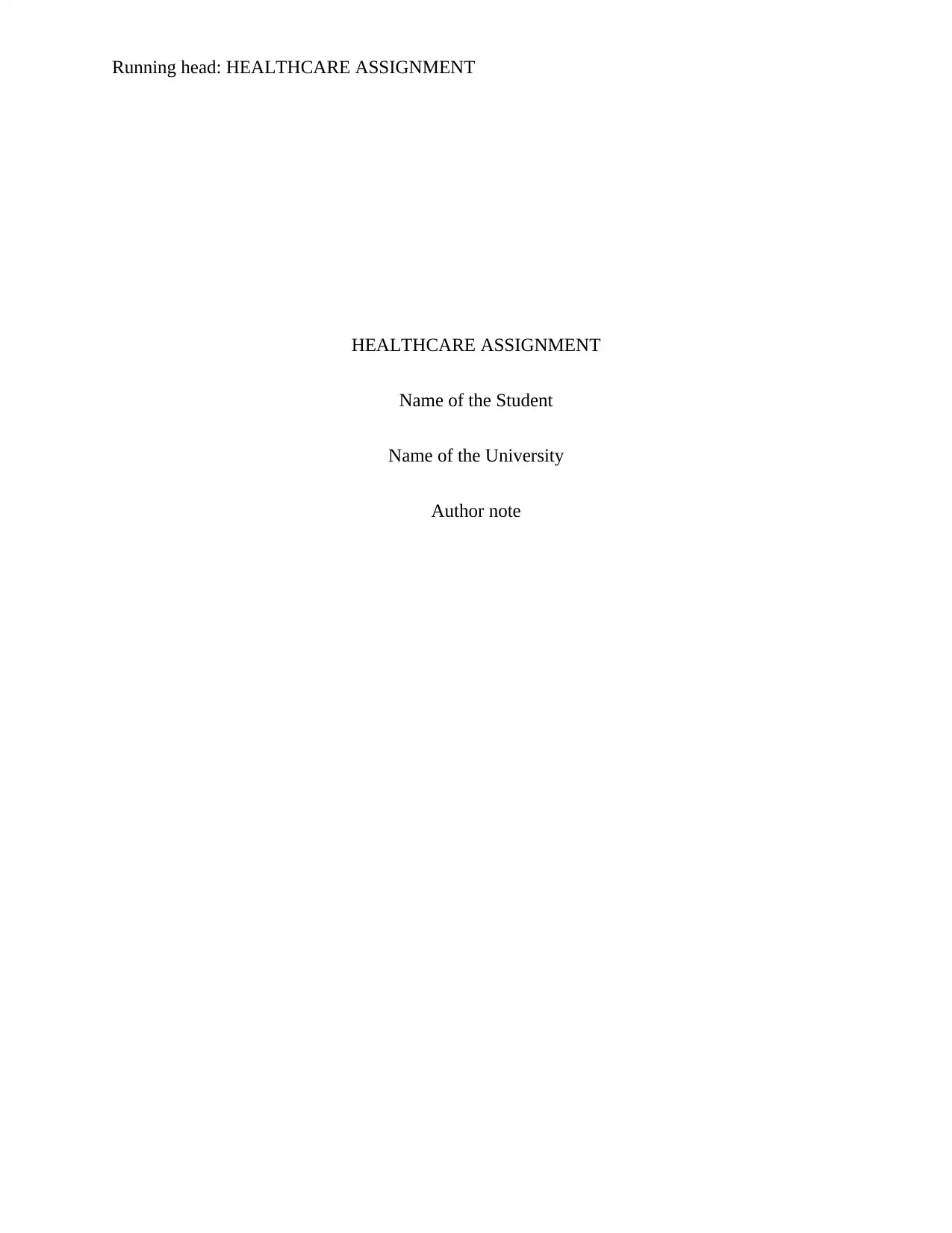
Running head: HEALTHCARE ASSIGNMENT
HEALTHCARE ASSIGNMENT
Name of the Student
Name of the University
Author note
HEALTHCARE ASSIGNMENT
Name of the Student
Name of the University
Author note
Paraphrase This Document
Need a fresh take? Get an instant paraphrase of this document with our AI Paraphraser
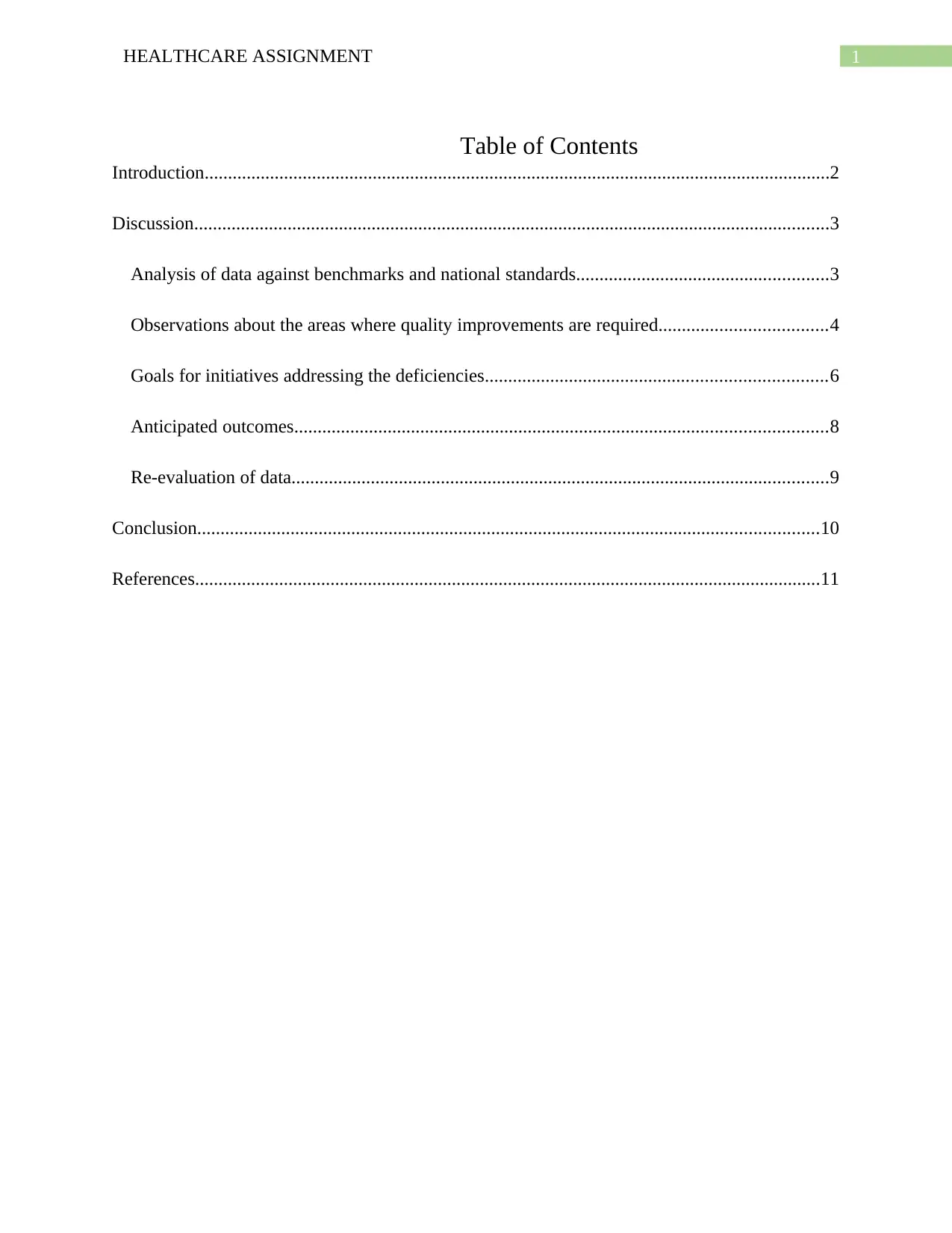
1HEALTHCARE ASSIGNMENT
Table of Contents
Introduction......................................................................................................................................2
Discussion........................................................................................................................................3
Analysis of data against benchmarks and national standards......................................................3
Observations about the areas where quality improvements are required....................................4
Goals for initiatives addressing the deficiencies.........................................................................6
Anticipated outcomes..................................................................................................................8
Re-evaluation of data...................................................................................................................9
Conclusion.....................................................................................................................................10
References......................................................................................................................................11
Table of Contents
Introduction......................................................................................................................................2
Discussion........................................................................................................................................3
Analysis of data against benchmarks and national standards......................................................3
Observations about the areas where quality improvements are required....................................4
Goals for initiatives addressing the deficiencies.........................................................................6
Anticipated outcomes..................................................................................................................8
Re-evaluation of data...................................................................................................................9
Conclusion.....................................................................................................................................10
References......................................................................................................................................11
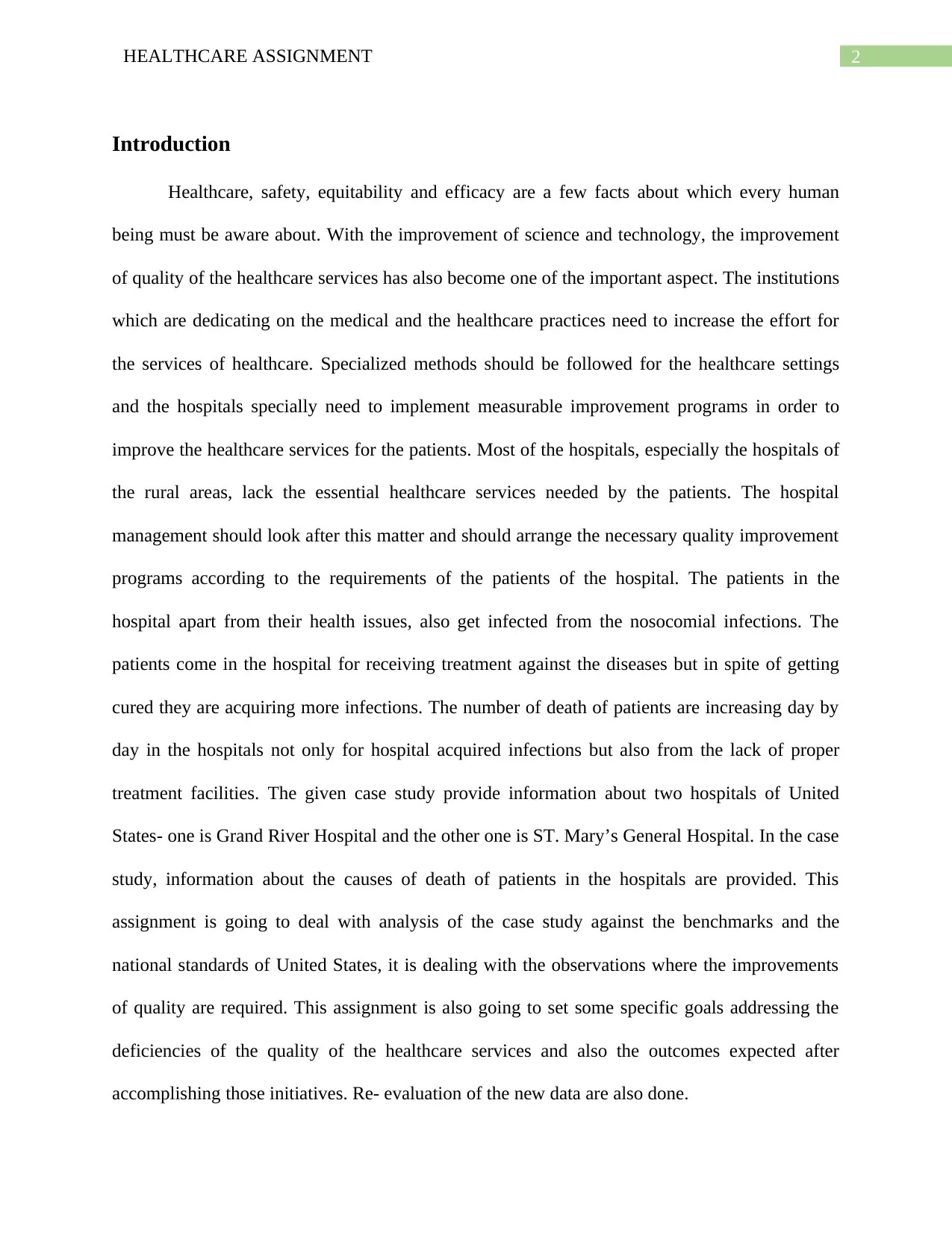
2HEALTHCARE ASSIGNMENT
Introduction
Healthcare, safety, equitability and efficacy are a few facts about which every human
being must be aware about. With the improvement of science and technology, the improvement
of quality of the healthcare services has also become one of the important aspect. The institutions
which are dedicating on the medical and the healthcare practices need to increase the effort for
the services of healthcare. Specialized methods should be followed for the healthcare settings
and the hospitals specially need to implement measurable improvement programs in order to
improve the healthcare services for the patients. Most of the hospitals, especially the hospitals of
the rural areas, lack the essential healthcare services needed by the patients. The hospital
management should look after this matter and should arrange the necessary quality improvement
programs according to the requirements of the patients of the hospital. The patients in the
hospital apart from their health issues, also get infected from the nosocomial infections. The
patients come in the hospital for receiving treatment against the diseases but in spite of getting
cured they are acquiring more infections. The number of death of patients are increasing day by
day in the hospitals not only for hospital acquired infections but also from the lack of proper
treatment facilities. The given case study provide information about two hospitals of United
States- one is Grand River Hospital and the other one is ST. Mary’s General Hospital. In the case
study, information about the causes of death of patients in the hospitals are provided. This
assignment is going to deal with analysis of the case study against the benchmarks and the
national standards of United States, it is dealing with the observations where the improvements
of quality are required. This assignment is also going to set some specific goals addressing the
deficiencies of the quality of the healthcare services and also the outcomes expected after
accomplishing those initiatives. Re- evaluation of the new data are also done.
Introduction
Healthcare, safety, equitability and efficacy are a few facts about which every human
being must be aware about. With the improvement of science and technology, the improvement
of quality of the healthcare services has also become one of the important aspect. The institutions
which are dedicating on the medical and the healthcare practices need to increase the effort for
the services of healthcare. Specialized methods should be followed for the healthcare settings
and the hospitals specially need to implement measurable improvement programs in order to
improve the healthcare services for the patients. Most of the hospitals, especially the hospitals of
the rural areas, lack the essential healthcare services needed by the patients. The hospital
management should look after this matter and should arrange the necessary quality improvement
programs according to the requirements of the patients of the hospital. The patients in the
hospital apart from their health issues, also get infected from the nosocomial infections. The
patients come in the hospital for receiving treatment against the diseases but in spite of getting
cured they are acquiring more infections. The number of death of patients are increasing day by
day in the hospitals not only for hospital acquired infections but also from the lack of proper
treatment facilities. The given case study provide information about two hospitals of United
States- one is Grand River Hospital and the other one is ST. Mary’s General Hospital. In the case
study, information about the causes of death of patients in the hospitals are provided. This
assignment is going to deal with analysis of the case study against the benchmarks and the
national standards of United States, it is dealing with the observations where the improvements
of quality are required. This assignment is also going to set some specific goals addressing the
deficiencies of the quality of the healthcare services and also the outcomes expected after
accomplishing those initiatives. Re- evaluation of the new data are also done.
⊘ This is a preview!⊘
Do you want full access?
Subscribe today to unlock all pages.

Trusted by 1+ million students worldwide
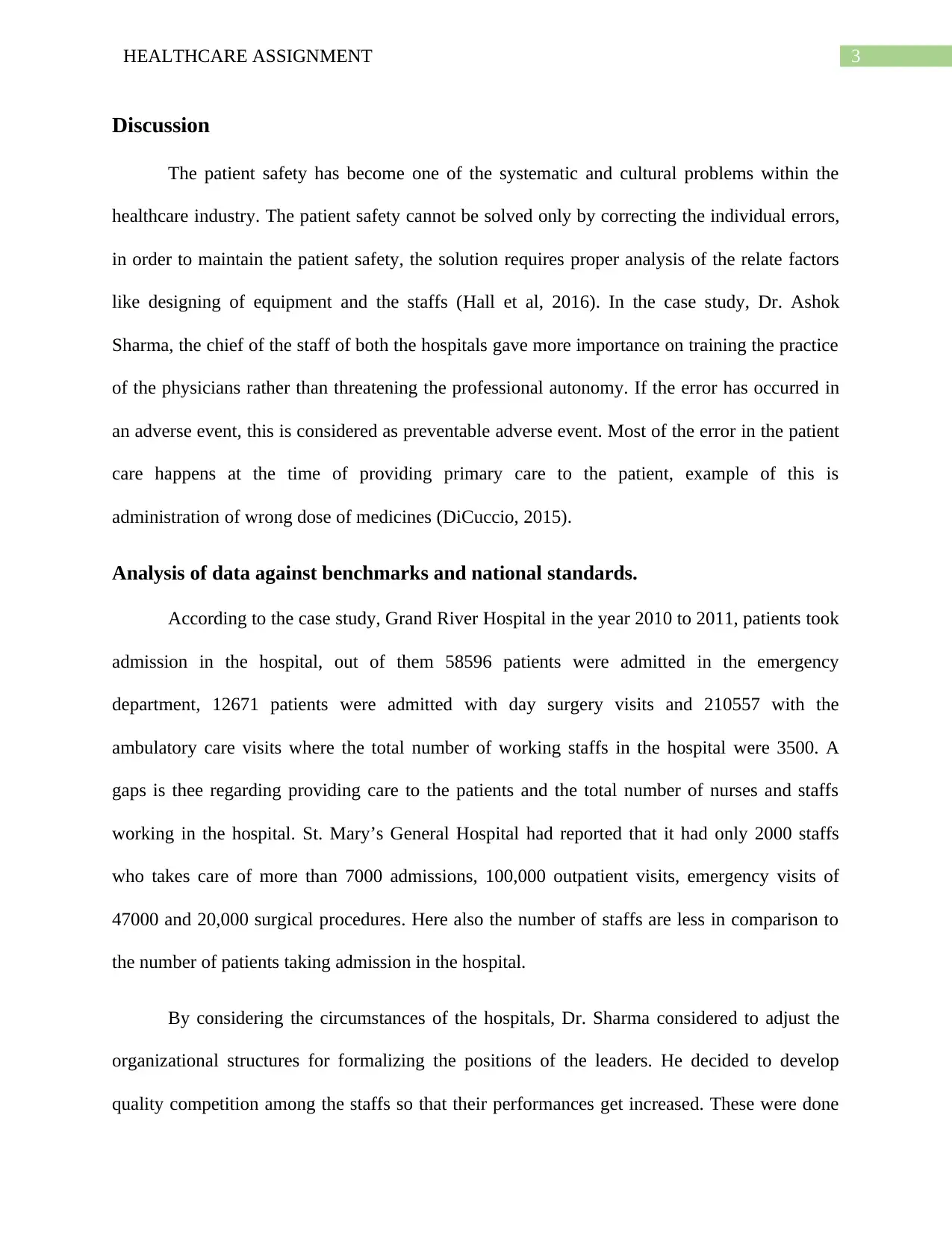
3HEALTHCARE ASSIGNMENT
Discussion
The patient safety has become one of the systematic and cultural problems within the
healthcare industry. The patient safety cannot be solved only by correcting the individual errors,
in order to maintain the patient safety, the solution requires proper analysis of the relate factors
like designing of equipment and the staffs (Hall et al, 2016). In the case study, Dr. Ashok
Sharma, the chief of the staff of both the hospitals gave more importance on training the practice
of the physicians rather than threatening the professional autonomy. If the error has occurred in
an adverse event, this is considered as preventable adverse event. Most of the error in the patient
care happens at the time of providing primary care to the patient, example of this is
administration of wrong dose of medicines (DiCuccio, 2015).
Analysis of data against benchmarks and national standards.
According to the case study, Grand River Hospital in the year 2010 to 2011, patients took
admission in the hospital, out of them 58596 patients were admitted in the emergency
department, 12671 patients were admitted with day surgery visits and 210557 with the
ambulatory care visits where the total number of working staffs in the hospital were 3500. A
gaps is thee regarding providing care to the patients and the total number of nurses and staffs
working in the hospital. St. Mary’s General Hospital had reported that it had only 2000 staffs
who takes care of more than 7000 admissions, 100,000 outpatient visits, emergency visits of
47000 and 20,000 surgical procedures. Here also the number of staffs are less in comparison to
the number of patients taking admission in the hospital.
By considering the circumstances of the hospitals, Dr. Sharma considered to adjust the
organizational structures for formalizing the positions of the leaders. He decided to develop
quality competition among the staffs so that their performances get increased. These were done
Discussion
The patient safety has become one of the systematic and cultural problems within the
healthcare industry. The patient safety cannot be solved only by correcting the individual errors,
in order to maintain the patient safety, the solution requires proper analysis of the relate factors
like designing of equipment and the staffs (Hall et al, 2016). In the case study, Dr. Ashok
Sharma, the chief of the staff of both the hospitals gave more importance on training the practice
of the physicians rather than threatening the professional autonomy. If the error has occurred in
an adverse event, this is considered as preventable adverse event. Most of the error in the patient
care happens at the time of providing primary care to the patient, example of this is
administration of wrong dose of medicines (DiCuccio, 2015).
Analysis of data against benchmarks and national standards.
According to the case study, Grand River Hospital in the year 2010 to 2011, patients took
admission in the hospital, out of them 58596 patients were admitted in the emergency
department, 12671 patients were admitted with day surgery visits and 210557 with the
ambulatory care visits where the total number of working staffs in the hospital were 3500. A
gaps is thee regarding providing care to the patients and the total number of nurses and staffs
working in the hospital. St. Mary’s General Hospital had reported that it had only 2000 staffs
who takes care of more than 7000 admissions, 100,000 outpatient visits, emergency visits of
47000 and 20,000 surgical procedures. Here also the number of staffs are less in comparison to
the number of patients taking admission in the hospital.
By considering the circumstances of the hospitals, Dr. Sharma considered to adjust the
organizational structures for formalizing the positions of the leaders. He decided to develop
quality competition among the staffs so that their performances get increased. These were done
Paraphrase This Document
Need a fresh take? Get an instant paraphrase of this document with our AI Paraphraser
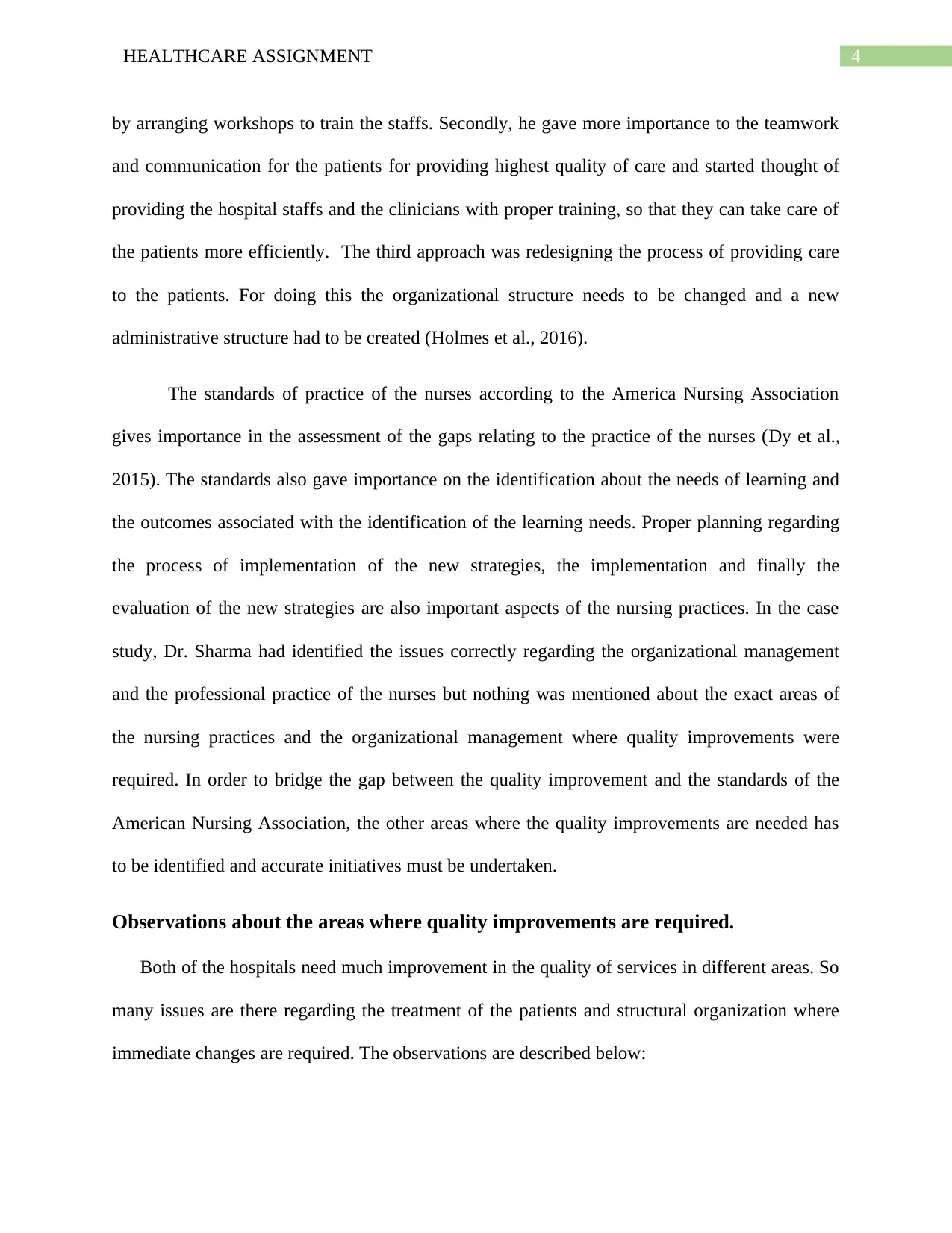
4HEALTHCARE ASSIGNMENT
by arranging workshops to train the staffs. Secondly, he gave more importance to the teamwork
and communication for the patients for providing highest quality of care and started thought of
providing the hospital staffs and the clinicians with proper training, so that they can take care of
the patients more efficiently. The third approach was redesigning the process of providing care
to the patients. For doing this the organizational structure needs to be changed and a new
administrative structure had to be created (Holmes et al., 2016).
The standards of practice of the nurses according to the America Nursing Association
gives importance in the assessment of the gaps relating to the practice of the nurses (Dy et al.,
2015). The standards also gave importance on the identification about the needs of learning and
the outcomes associated with the identification of the learning needs. Proper planning regarding
the process of implementation of the new strategies, the implementation and finally the
evaluation of the new strategies are also important aspects of the nursing practices. In the case
study, Dr. Sharma had identified the issues correctly regarding the organizational management
and the professional practice of the nurses but nothing was mentioned about the exact areas of
the nursing practices and the organizational management where quality improvements were
required. In order to bridge the gap between the quality improvement and the standards of the
American Nursing Association, the other areas where the quality improvements are needed has
to be identified and accurate initiatives must be undertaken.
Observations about the areas where quality improvements are required.
Both of the hospitals need much improvement in the quality of services in different areas. So
many issues are there regarding the treatment of the patients and structural organization where
immediate changes are required. The observations are described below:
by arranging workshops to train the staffs. Secondly, he gave more importance to the teamwork
and communication for the patients for providing highest quality of care and started thought of
providing the hospital staffs and the clinicians with proper training, so that they can take care of
the patients more efficiently. The third approach was redesigning the process of providing care
to the patients. For doing this the organizational structure needs to be changed and a new
administrative structure had to be created (Holmes et al., 2016).
The standards of practice of the nurses according to the America Nursing Association
gives importance in the assessment of the gaps relating to the practice of the nurses (Dy et al.,
2015). The standards also gave importance on the identification about the needs of learning and
the outcomes associated with the identification of the learning needs. Proper planning regarding
the process of implementation of the new strategies, the implementation and finally the
evaluation of the new strategies are also important aspects of the nursing practices. In the case
study, Dr. Sharma had identified the issues correctly regarding the organizational management
and the professional practice of the nurses but nothing was mentioned about the exact areas of
the nursing practices and the organizational management where quality improvements were
required. In order to bridge the gap between the quality improvement and the standards of the
American Nursing Association, the other areas where the quality improvements are needed has
to be identified and accurate initiatives must be undertaken.
Observations about the areas where quality improvements are required.
Both of the hospitals need much improvement in the quality of services in different areas. So
many issues are there regarding the treatment of the patients and structural organization where
immediate changes are required. The observations are described below:
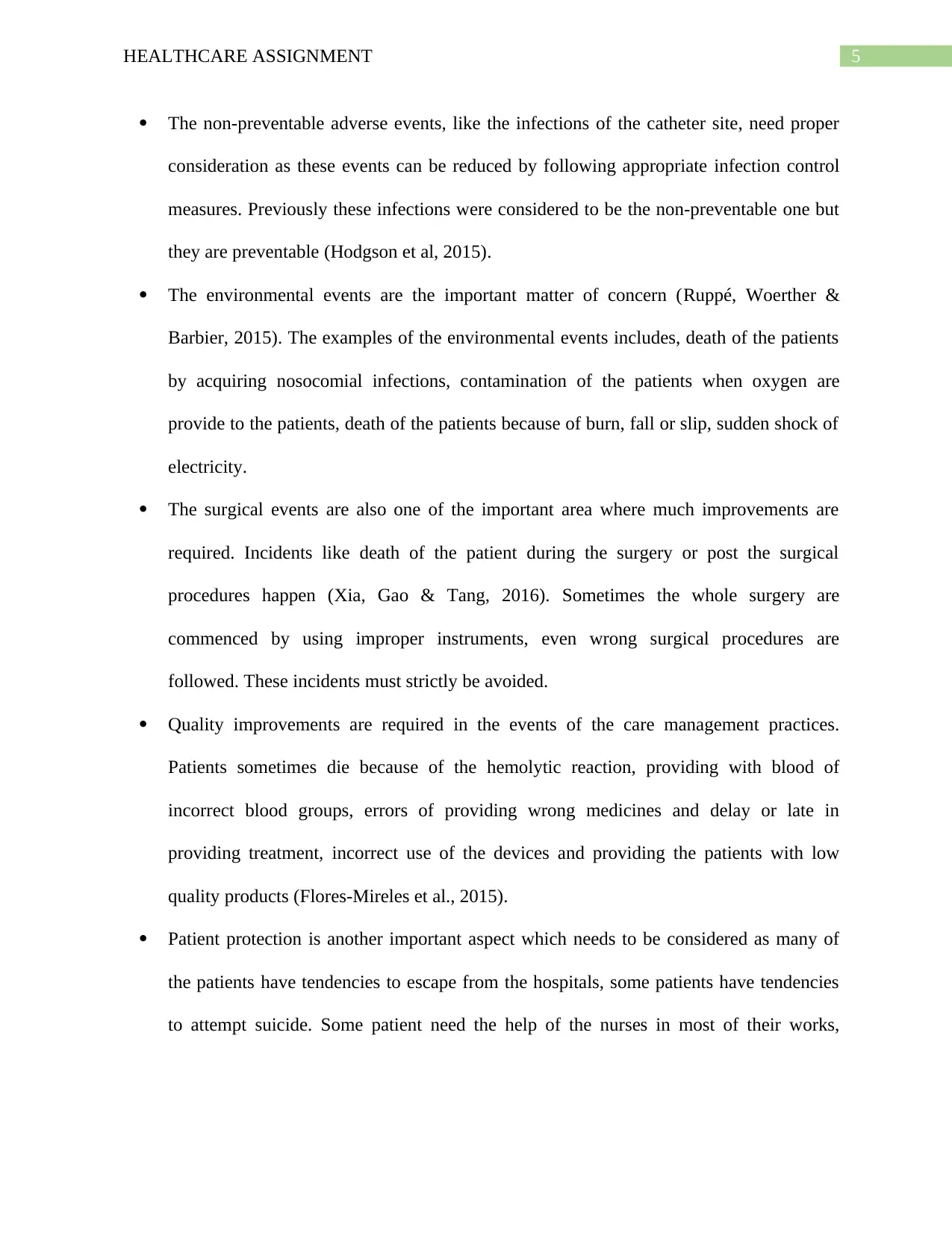
5HEALTHCARE ASSIGNMENT
The non-preventable adverse events, like the infections of the catheter site, need proper
consideration as these events can be reduced by following appropriate infection control
measures. Previously these infections were considered to be the non-preventable one but
they are preventable (Hodgson et al, 2015).
The environmental events are the important matter of concern (Ruppé, Woerther &
Barbier, 2015). The examples of the environmental events includes, death of the patients
by acquiring nosocomial infections, contamination of the patients when oxygen are
provide to the patients, death of the patients because of burn, fall or slip, sudden shock of
electricity.
The surgical events are also one of the important area where much improvements are
required. Incidents like death of the patient during the surgery or post the surgical
procedures happen (Xia, Gao & Tang, 2016). Sometimes the whole surgery are
commenced by using improper instruments, even wrong surgical procedures are
followed. These incidents must strictly be avoided.
Quality improvements are required in the events of the care management practices.
Patients sometimes die because of the hemolytic reaction, providing with blood of
incorrect blood groups, errors of providing wrong medicines and delay or late in
providing treatment, incorrect use of the devices and providing the patients with low
quality products (Flores-Mireles et al., 2015).
Patient protection is another important aspect which needs to be considered as many of
the patients have tendencies to escape from the hospitals, some patients have tendencies
to attempt suicide. Some patient need the help of the nurses in most of their works,
The non-preventable adverse events, like the infections of the catheter site, need proper
consideration as these events can be reduced by following appropriate infection control
measures. Previously these infections were considered to be the non-preventable one but
they are preventable (Hodgson et al, 2015).
The environmental events are the important matter of concern (Ruppé, Woerther &
Barbier, 2015). The examples of the environmental events includes, death of the patients
by acquiring nosocomial infections, contamination of the patients when oxygen are
provide to the patients, death of the patients because of burn, fall or slip, sudden shock of
electricity.
The surgical events are also one of the important area where much improvements are
required. Incidents like death of the patient during the surgery or post the surgical
procedures happen (Xia, Gao & Tang, 2016). Sometimes the whole surgery are
commenced by using improper instruments, even wrong surgical procedures are
followed. These incidents must strictly be avoided.
Quality improvements are required in the events of the care management practices.
Patients sometimes die because of the hemolytic reaction, providing with blood of
incorrect blood groups, errors of providing wrong medicines and delay or late in
providing treatment, incorrect use of the devices and providing the patients with low
quality products (Flores-Mireles et al., 2015).
Patient protection is another important aspect which needs to be considered as many of
the patients have tendencies to escape from the hospitals, some patients have tendencies
to attempt suicide. Some patient need the help of the nurses in most of their works,
⊘ This is a preview!⊘
Do you want full access?
Subscribe today to unlock all pages.

Trusted by 1+ million students worldwide
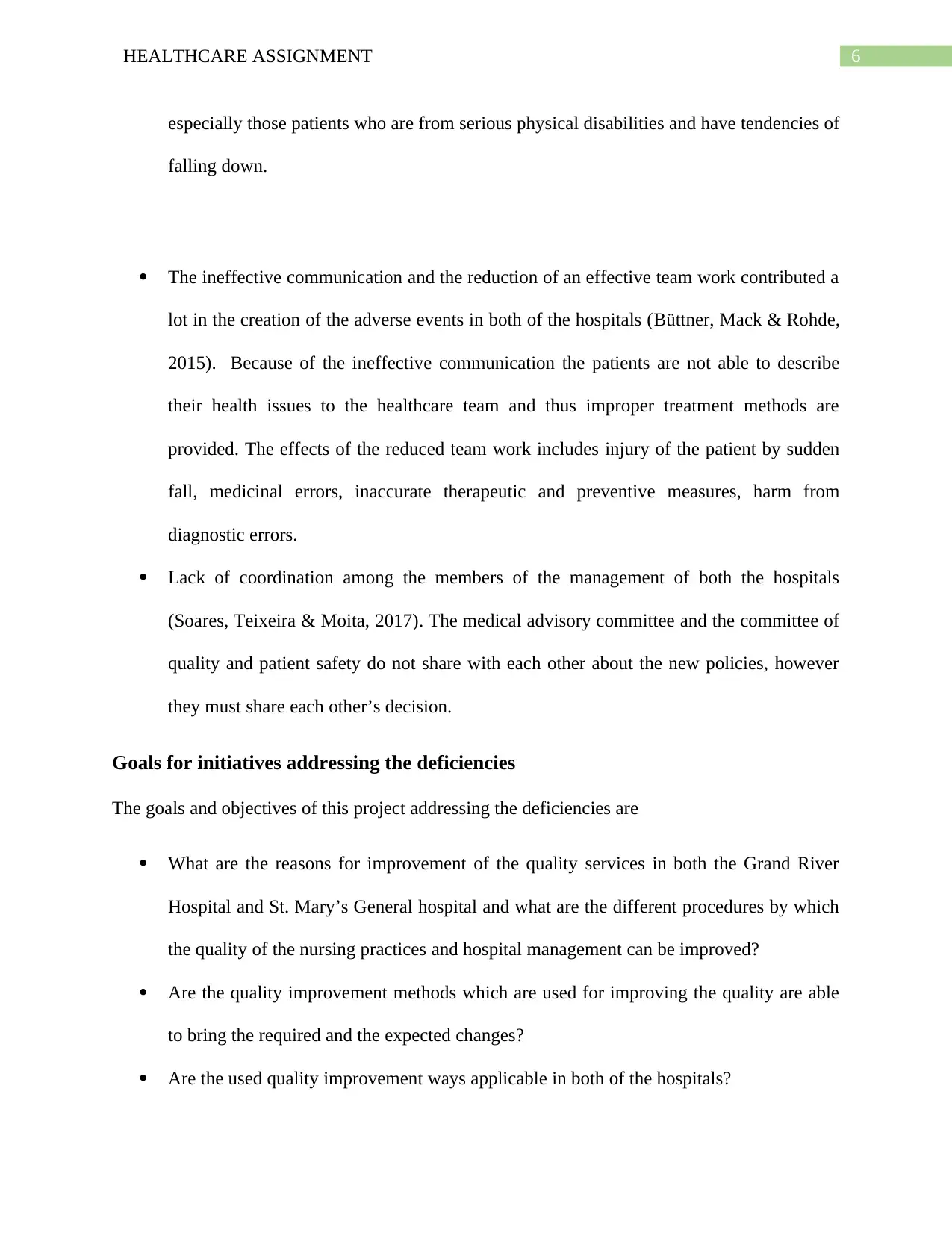
6HEALTHCARE ASSIGNMENT
especially those patients who are from serious physical disabilities and have tendencies of
falling down.
The ineffective communication and the reduction of an effective team work contributed a
lot in the creation of the adverse events in both of the hospitals (Büttner, Mack & Rohde,
2015). Because of the ineffective communication the patients are not able to describe
their health issues to the healthcare team and thus improper treatment methods are
provided. The effects of the reduced team work includes injury of the patient by sudden
fall, medicinal errors, inaccurate therapeutic and preventive measures, harm from
diagnostic errors.
Lack of coordination among the members of the management of both the hospitals
(Soares, Teixeira & Moita, 2017). The medical advisory committee and the committee of
quality and patient safety do not share with each other about the new policies, however
they must share each other’s decision.
Goals for initiatives addressing the deficiencies
The goals and objectives of this project addressing the deficiencies are
What are the reasons for improvement of the quality services in both the Grand River
Hospital and St. Mary’s General hospital and what are the different procedures by which
the quality of the nursing practices and hospital management can be improved?
Are the quality improvement methods which are used for improving the quality are able
to bring the required and the expected changes?
Are the used quality improvement ways applicable in both of the hospitals?
especially those patients who are from serious physical disabilities and have tendencies of
falling down.
The ineffective communication and the reduction of an effective team work contributed a
lot in the creation of the adverse events in both of the hospitals (Büttner, Mack & Rohde,
2015). Because of the ineffective communication the patients are not able to describe
their health issues to the healthcare team and thus improper treatment methods are
provided. The effects of the reduced team work includes injury of the patient by sudden
fall, medicinal errors, inaccurate therapeutic and preventive measures, harm from
diagnostic errors.
Lack of coordination among the members of the management of both the hospitals
(Soares, Teixeira & Moita, 2017). The medical advisory committee and the committee of
quality and patient safety do not share with each other about the new policies, however
they must share each other’s decision.
Goals for initiatives addressing the deficiencies
The goals and objectives of this project addressing the deficiencies are
What are the reasons for improvement of the quality services in both the Grand River
Hospital and St. Mary’s General hospital and what are the different procedures by which
the quality of the nursing practices and hospital management can be improved?
Are the quality improvement methods which are used for improving the quality are able
to bring the required and the expected changes?
Are the used quality improvement ways applicable in both of the hospitals?
Paraphrase This Document
Need a fresh take? Get an instant paraphrase of this document with our AI Paraphraser
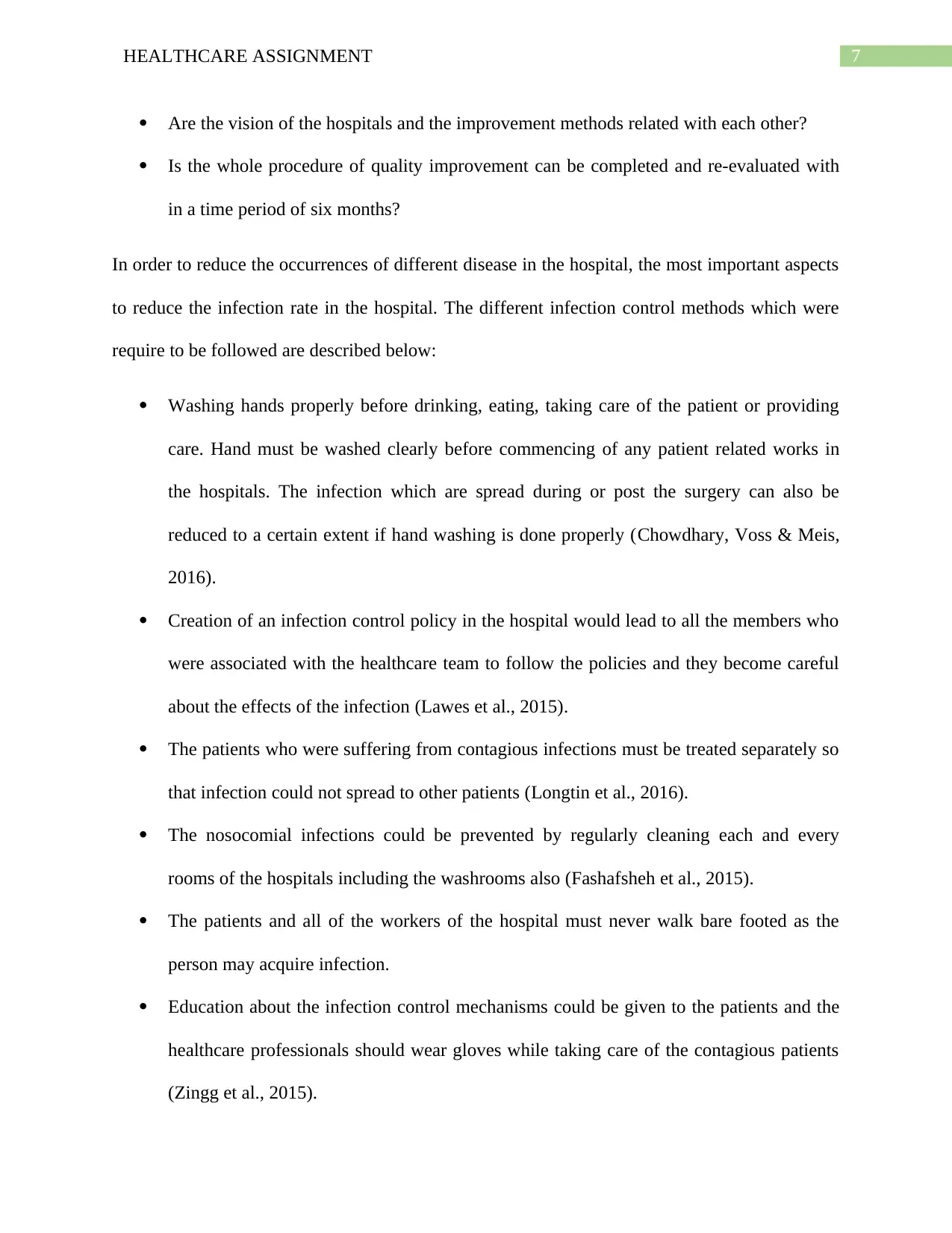
7HEALTHCARE ASSIGNMENT
Are the vision of the hospitals and the improvement methods related with each other?
Is the whole procedure of quality improvement can be completed and re-evaluated with
in a time period of six months?
In order to reduce the occurrences of different disease in the hospital, the most important aspects
to reduce the infection rate in the hospital. The different infection control methods which were
require to be followed are described below:
Washing hands properly before drinking, eating, taking care of the patient or providing
care. Hand must be washed clearly before commencing of any patient related works in
the hospitals. The infection which are spread during or post the surgery can also be
reduced to a certain extent if hand washing is done properly (Chowdhary, Voss & Meis,
2016).
Creation of an infection control policy in the hospital would lead to all the members who
were associated with the healthcare team to follow the policies and they become careful
about the effects of the infection (Lawes et al., 2015).
The patients who were suffering from contagious infections must be treated separately so
that infection could not spread to other patients (Longtin et al., 2016).
The nosocomial infections could be prevented by regularly cleaning each and every
rooms of the hospitals including the washrooms also (Fashafsheh et al., 2015).
The patients and all of the workers of the hospital must never walk bare footed as the
person may acquire infection.
Education about the infection control mechanisms could be given to the patients and the
healthcare professionals should wear gloves while taking care of the contagious patients
(Zingg et al., 2015).
Are the vision of the hospitals and the improvement methods related with each other?
Is the whole procedure of quality improvement can be completed and re-evaluated with
in a time period of six months?
In order to reduce the occurrences of different disease in the hospital, the most important aspects
to reduce the infection rate in the hospital. The different infection control methods which were
require to be followed are described below:
Washing hands properly before drinking, eating, taking care of the patient or providing
care. Hand must be washed clearly before commencing of any patient related works in
the hospitals. The infection which are spread during or post the surgery can also be
reduced to a certain extent if hand washing is done properly (Chowdhary, Voss & Meis,
2016).
Creation of an infection control policy in the hospital would lead to all the members who
were associated with the healthcare team to follow the policies and they become careful
about the effects of the infection (Lawes et al., 2015).
The patients who were suffering from contagious infections must be treated separately so
that infection could not spread to other patients (Longtin et al., 2016).
The nosocomial infections could be prevented by regularly cleaning each and every
rooms of the hospitals including the washrooms also (Fashafsheh et al., 2015).
The patients and all of the workers of the hospital must never walk bare footed as the
person may acquire infection.
Education about the infection control mechanisms could be given to the patients and the
healthcare professionals should wear gloves while taking care of the contagious patients
(Zingg et al., 2015).
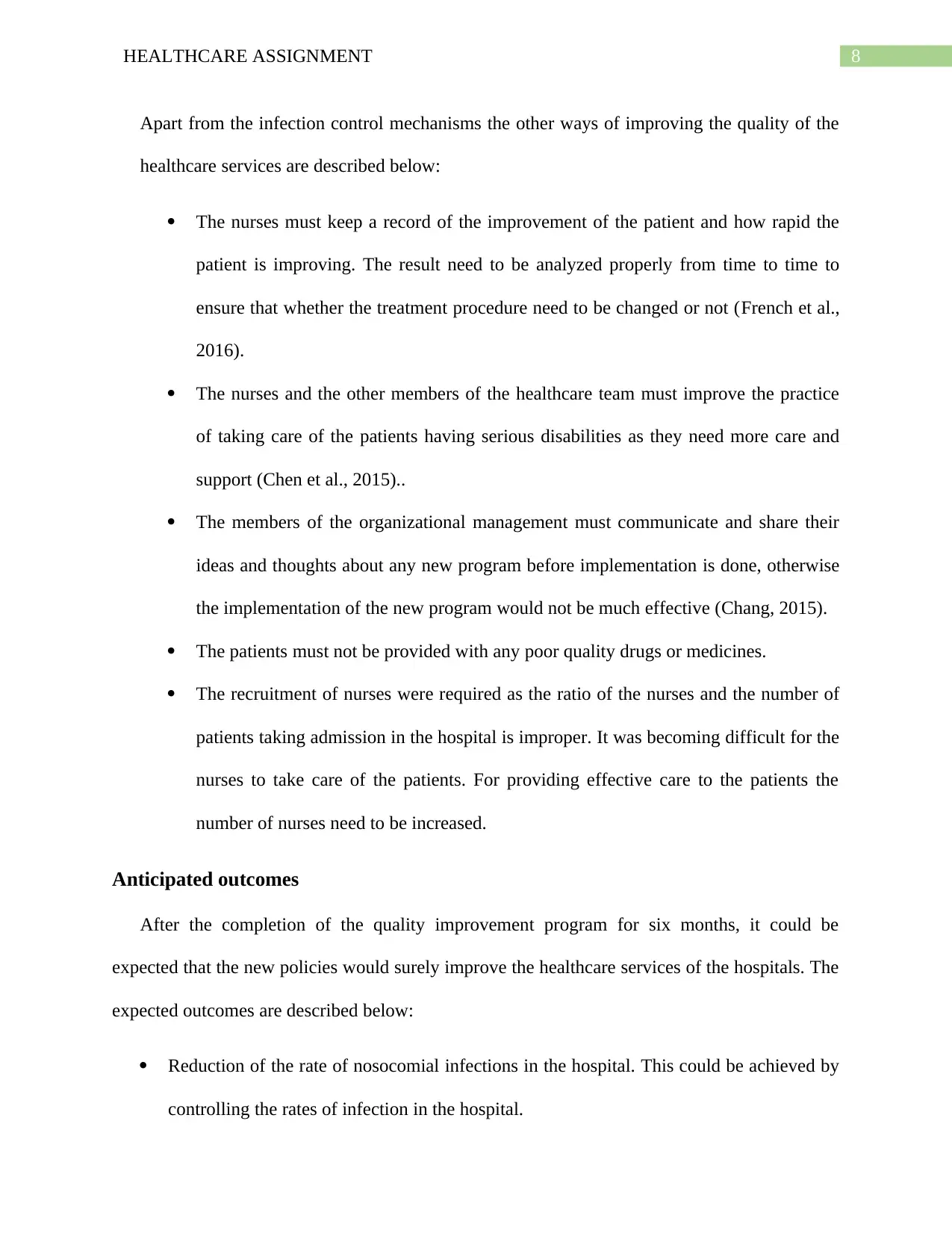
8HEALTHCARE ASSIGNMENT
Apart from the infection control mechanisms the other ways of improving the quality of the
healthcare services are described below:
The nurses must keep a record of the improvement of the patient and how rapid the
patient is improving. The result need to be analyzed properly from time to time to
ensure that whether the treatment procedure need to be changed or not (French et al.,
2016).
The nurses and the other members of the healthcare team must improve the practice
of taking care of the patients having serious disabilities as they need more care and
support (Chen et al., 2015)..
The members of the organizational management must communicate and share their
ideas and thoughts about any new program before implementation is done, otherwise
the implementation of the new program would not be much effective (Chang, 2015).
The patients must not be provided with any poor quality drugs or medicines.
The recruitment of nurses were required as the ratio of the nurses and the number of
patients taking admission in the hospital is improper. It was becoming difficult for the
nurses to take care of the patients. For providing effective care to the patients the
number of nurses need to be increased.
Anticipated outcomes
After the completion of the quality improvement program for six months, it could be
expected that the new policies would surely improve the healthcare services of the hospitals. The
expected outcomes are described below:
Reduction of the rate of nosocomial infections in the hospital. This could be achieved by
controlling the rates of infection in the hospital.
Apart from the infection control mechanisms the other ways of improving the quality of the
healthcare services are described below:
The nurses must keep a record of the improvement of the patient and how rapid the
patient is improving. The result need to be analyzed properly from time to time to
ensure that whether the treatment procedure need to be changed or not (French et al.,
2016).
The nurses and the other members of the healthcare team must improve the practice
of taking care of the patients having serious disabilities as they need more care and
support (Chen et al., 2015)..
The members of the organizational management must communicate and share their
ideas and thoughts about any new program before implementation is done, otherwise
the implementation of the new program would not be much effective (Chang, 2015).
The patients must not be provided with any poor quality drugs or medicines.
The recruitment of nurses were required as the ratio of the nurses and the number of
patients taking admission in the hospital is improper. It was becoming difficult for the
nurses to take care of the patients. For providing effective care to the patients the
number of nurses need to be increased.
Anticipated outcomes
After the completion of the quality improvement program for six months, it could be
expected that the new policies would surely improve the healthcare services of the hospitals. The
expected outcomes are described below:
Reduction of the rate of nosocomial infections in the hospital. This could be achieved by
controlling the rates of infection in the hospital.
⊘ This is a preview!⊘
Do you want full access?
Subscribe today to unlock all pages.

Trusted by 1+ million students worldwide
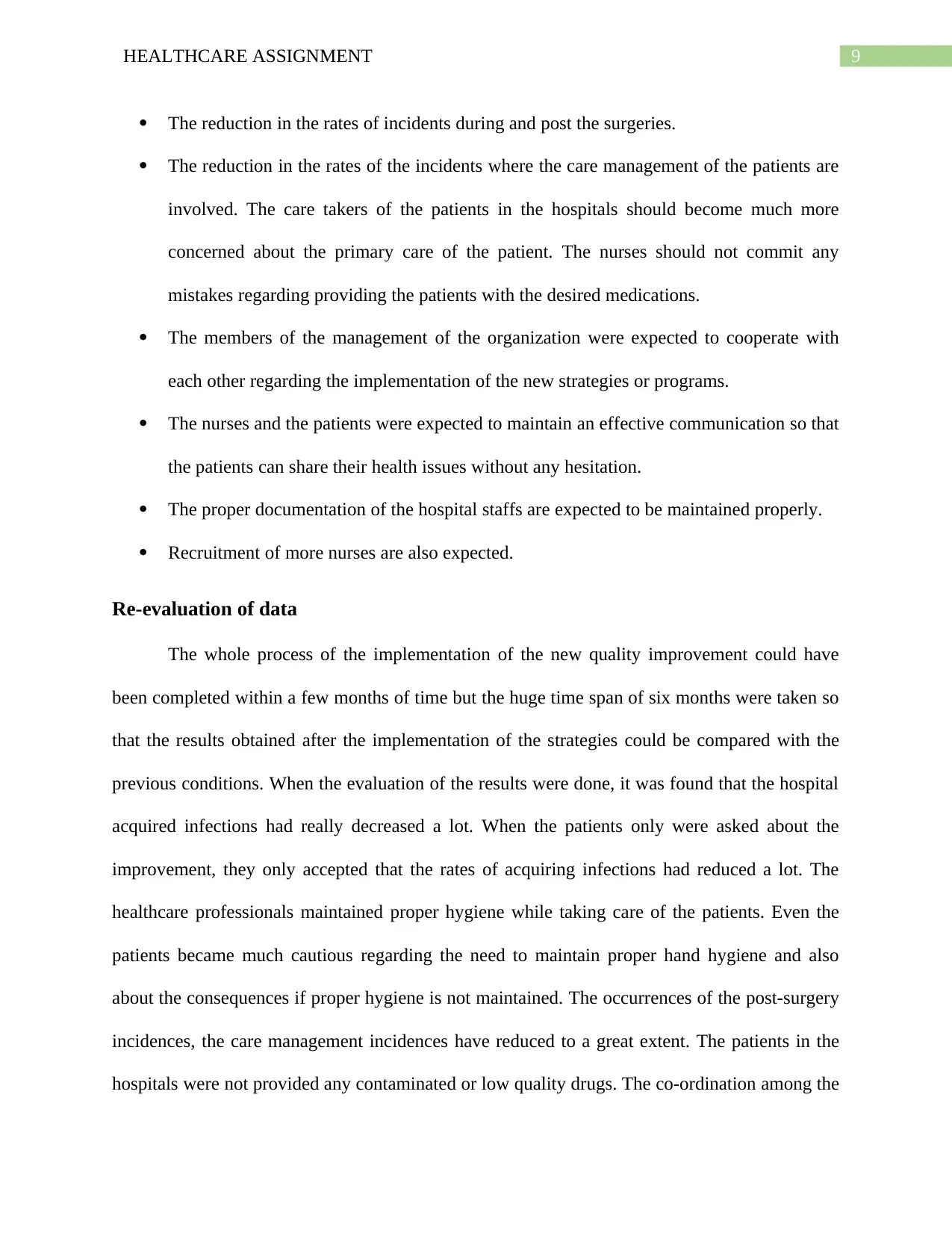
9HEALTHCARE ASSIGNMENT
The reduction in the rates of incidents during and post the surgeries.
The reduction in the rates of the incidents where the care management of the patients are
involved. The care takers of the patients in the hospitals should become much more
concerned about the primary care of the patient. The nurses should not commit any
mistakes regarding providing the patients with the desired medications.
The members of the management of the organization were expected to cooperate with
each other regarding the implementation of the new strategies or programs.
The nurses and the patients were expected to maintain an effective communication so that
the patients can share their health issues without any hesitation.
The proper documentation of the hospital staffs are expected to be maintained properly.
Recruitment of more nurses are also expected.
Re-evaluation of data
The whole process of the implementation of the new quality improvement could have
been completed within a few months of time but the huge time span of six months were taken so
that the results obtained after the implementation of the strategies could be compared with the
previous conditions. When the evaluation of the results were done, it was found that the hospital
acquired infections had really decreased a lot. When the patients only were asked about the
improvement, they only accepted that the rates of acquiring infections had reduced a lot. The
healthcare professionals maintained proper hygiene while taking care of the patients. Even the
patients became much cautious regarding the need to maintain proper hand hygiene and also
about the consequences if proper hygiene is not maintained. The occurrences of the post-surgery
incidences, the care management incidences have reduced to a great extent. The patients in the
hospitals were not provided any contaminated or low quality drugs. The co-ordination among the
The reduction in the rates of incidents during and post the surgeries.
The reduction in the rates of the incidents where the care management of the patients are
involved. The care takers of the patients in the hospitals should become much more
concerned about the primary care of the patient. The nurses should not commit any
mistakes regarding providing the patients with the desired medications.
The members of the management of the organization were expected to cooperate with
each other regarding the implementation of the new strategies or programs.
The nurses and the patients were expected to maintain an effective communication so that
the patients can share their health issues without any hesitation.
The proper documentation of the hospital staffs are expected to be maintained properly.
Recruitment of more nurses are also expected.
Re-evaluation of data
The whole process of the implementation of the new quality improvement could have
been completed within a few months of time but the huge time span of six months were taken so
that the results obtained after the implementation of the strategies could be compared with the
previous conditions. When the evaluation of the results were done, it was found that the hospital
acquired infections had really decreased a lot. When the patients only were asked about the
improvement, they only accepted that the rates of acquiring infections had reduced a lot. The
healthcare professionals maintained proper hygiene while taking care of the patients. Even the
patients became much cautious regarding the need to maintain proper hand hygiene and also
about the consequences if proper hygiene is not maintained. The occurrences of the post-surgery
incidences, the care management incidences have reduced to a great extent. The patients in the
hospitals were not provided any contaminated or low quality drugs. The co-ordination among the
Paraphrase This Document
Need a fresh take? Get an instant paraphrase of this document with our AI Paraphraser
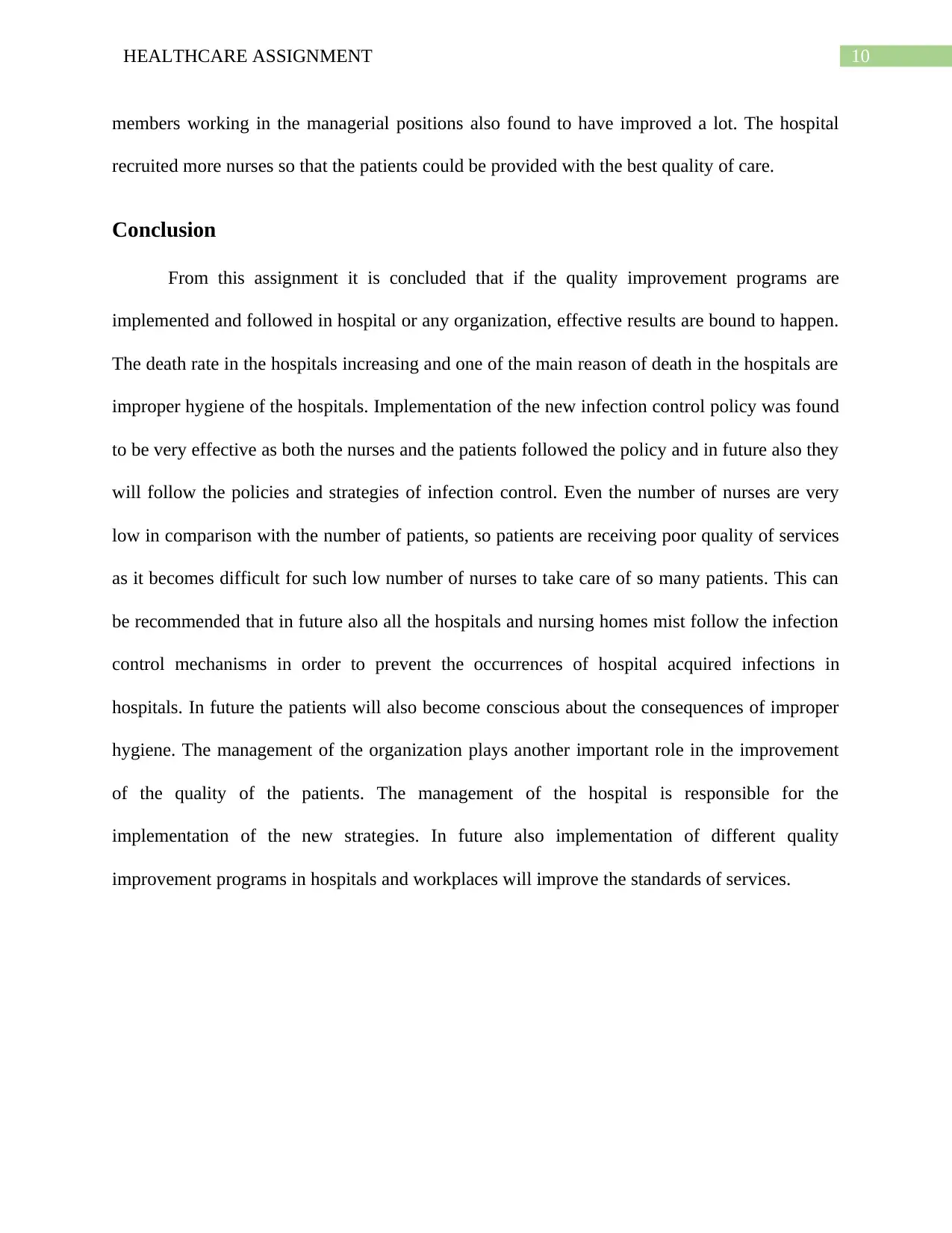
10HEALTHCARE ASSIGNMENT
members working in the managerial positions also found to have improved a lot. The hospital
recruited more nurses so that the patients could be provided with the best quality of care.
Conclusion
From this assignment it is concluded that if the quality improvement programs are
implemented and followed in hospital or any organization, effective results are bound to happen.
The death rate in the hospitals increasing and one of the main reason of death in the hospitals are
improper hygiene of the hospitals. Implementation of the new infection control policy was found
to be very effective as both the nurses and the patients followed the policy and in future also they
will follow the policies and strategies of infection control. Even the number of nurses are very
low in comparison with the number of patients, so patients are receiving poor quality of services
as it becomes difficult for such low number of nurses to take care of so many patients. This can
be recommended that in future also all the hospitals and nursing homes mist follow the infection
control mechanisms in order to prevent the occurrences of hospital acquired infections in
hospitals. In future the patients will also become conscious about the consequences of improper
hygiene. The management of the organization plays another important role in the improvement
of the quality of the patients. The management of the hospital is responsible for the
implementation of the new strategies. In future also implementation of different quality
improvement programs in hospitals and workplaces will improve the standards of services.
members working in the managerial positions also found to have improved a lot. The hospital
recruited more nurses so that the patients could be provided with the best quality of care.
Conclusion
From this assignment it is concluded that if the quality improvement programs are
implemented and followed in hospital or any organization, effective results are bound to happen.
The death rate in the hospitals increasing and one of the main reason of death in the hospitals are
improper hygiene of the hospitals. Implementation of the new infection control policy was found
to be very effective as both the nurses and the patients followed the policy and in future also they
will follow the policies and strategies of infection control. Even the number of nurses are very
low in comparison with the number of patients, so patients are receiving poor quality of services
as it becomes difficult for such low number of nurses to take care of so many patients. This can
be recommended that in future also all the hospitals and nursing homes mist follow the infection
control mechanisms in order to prevent the occurrences of hospital acquired infections in
hospitals. In future the patients will also become conscious about the consequences of improper
hygiene. The management of the organization plays another important role in the improvement
of the quality of the patients. The management of the hospital is responsible for the
implementation of the new strategies. In future also implementation of different quality
improvement programs in hospitals and workplaces will improve the standards of services.
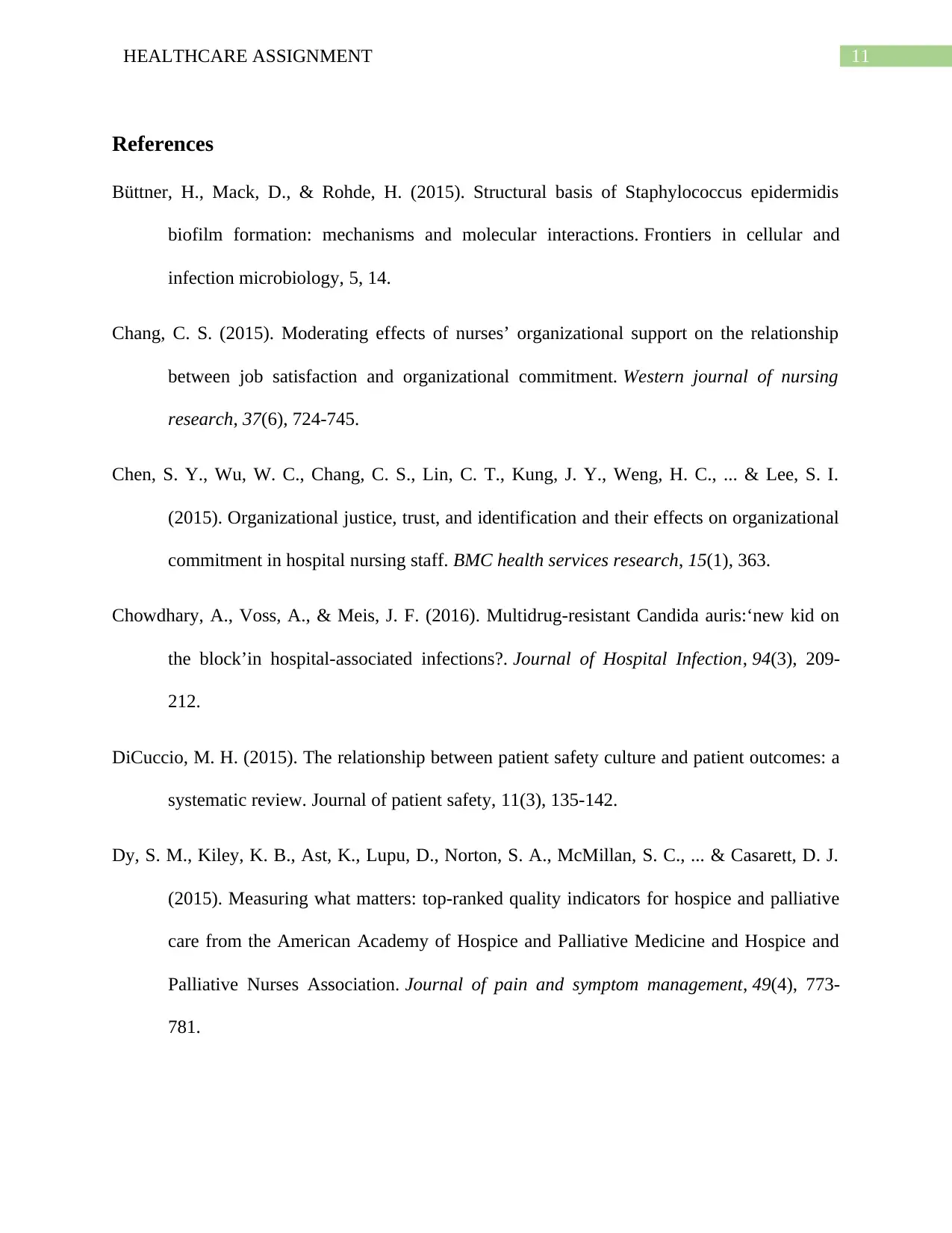
11HEALTHCARE ASSIGNMENT
References
Büttner, H., Mack, D., & Rohde, H. (2015). Structural basis of Staphylococcus epidermidis
biofilm formation: mechanisms and molecular interactions. Frontiers in cellular and
infection microbiology, 5, 14.
Chang, C. S. (2015). Moderating effects of nurses’ organizational support on the relationship
between job satisfaction and organizational commitment. Western journal of nursing
research, 37(6), 724-745.
Chen, S. Y., Wu, W. C., Chang, C. S., Lin, C. T., Kung, J. Y., Weng, H. C., ... & Lee, S. I.
(2015). Organizational justice, trust, and identification and their effects on organizational
commitment in hospital nursing staff. BMC health services research, 15(1), 363.
Chowdhary, A., Voss, A., & Meis, J. F. (2016). Multidrug-resistant Candida auris:‘new kid on
the block’in hospital-associated infections?. Journal of Hospital Infection, 94(3), 209-
212.
DiCuccio, M. H. (2015). The relationship between patient safety culture and patient outcomes: a
systematic review. Journal of patient safety, 11(3), 135-142.
Dy, S. M., Kiley, K. B., Ast, K., Lupu, D., Norton, S. A., McMillan, S. C., ... & Casarett, D. J.
(2015). Measuring what matters: top-ranked quality indicators for hospice and palliative
care from the American Academy of Hospice and Palliative Medicine and Hospice and
Palliative Nurses Association. Journal of pain and symptom management, 49(4), 773-
781.
References
Büttner, H., Mack, D., & Rohde, H. (2015). Structural basis of Staphylococcus epidermidis
biofilm formation: mechanisms and molecular interactions. Frontiers in cellular and
infection microbiology, 5, 14.
Chang, C. S. (2015). Moderating effects of nurses’ organizational support on the relationship
between job satisfaction and organizational commitment. Western journal of nursing
research, 37(6), 724-745.
Chen, S. Y., Wu, W. C., Chang, C. S., Lin, C. T., Kung, J. Y., Weng, H. C., ... & Lee, S. I.
(2015). Organizational justice, trust, and identification and their effects on organizational
commitment in hospital nursing staff. BMC health services research, 15(1), 363.
Chowdhary, A., Voss, A., & Meis, J. F. (2016). Multidrug-resistant Candida auris:‘new kid on
the block’in hospital-associated infections?. Journal of Hospital Infection, 94(3), 209-
212.
DiCuccio, M. H. (2015). The relationship between patient safety culture and patient outcomes: a
systematic review. Journal of patient safety, 11(3), 135-142.
Dy, S. M., Kiley, K. B., Ast, K., Lupu, D., Norton, S. A., McMillan, S. C., ... & Casarett, D. J.
(2015). Measuring what matters: top-ranked quality indicators for hospice and palliative
care from the American Academy of Hospice and Palliative Medicine and Hospice and
Palliative Nurses Association. Journal of pain and symptom management, 49(4), 773-
781.
⊘ This is a preview!⊘
Do you want full access?
Subscribe today to unlock all pages.

Trusted by 1+ million students worldwide
1 out of 14
Related Documents
Your All-in-One AI-Powered Toolkit for Academic Success.
+13062052269
info@desklib.com
Available 24*7 on WhatsApp / Email
![[object Object]](/_next/static/media/star-bottom.7253800d.svg)
Unlock your academic potential
Copyright © 2020–2025 A2Z Services. All Rights Reserved. Developed and managed by ZUCOL.





